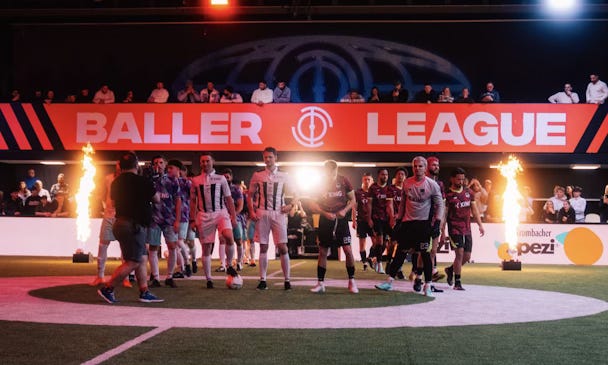From VAR Fatigue to Fight Night Thrills: Is Baller League the Shake-Up Football Needs?
How Felix Starck’s vision for a fast-paced, hero-driven football league challenges tradition and captivates modern audiences.
The Baller League is reimagining football for the modern era. CEO Felix Starck describes it as “the UFC of football,” a statement reflecting its ambition to blend sports with entertainment and redefine how audiences engage with the game.
In just one year, the league has garnered massive attention, thanks to its innovative format: fast-paced six-a-side matches aired for free on YouTube and Twitch. With a roster featuring stars like Luis Figo, John Terry, and influencers such as KSI and IShowSpeed, the league is a product tailor-made for the attention economy, providing an interesting alternative to football consumption.
The Rise of Hero Storytelling in Sports
Starck’s vision aligns with the principles that propelled UFC’s growth under Dana White. The UFC’s success wasn’t just about fights; it was about the fighters. Starck has stated, “We need to create heroes, not just players,” acknowledging that sports fandom is shifting from club loyalty to individual admiration. Behavioral science supports this, suggesting that audiences connect more deeply with narratives centered around identifiable figures. For example, Rory Sutherland, a champion of behavioral economics, often highlights the importance of creating "sticky" emotional moments in branding – moments that are both memorable and personal.
The Baller League taps into this trend by curating star-driven storylines. By featuring a mix of traditional athletes and internet personalities, the league ensures its appeal transcends football’s traditional audience. This hybrid approach leverages what media scholar Henry Jenkins calls convergence culture, blending the old and the new to create a product that feels fresh yet familiar.
Adapting to the Attention Economy
In an age where the average person is inundated with media, attention is the ultimate currency. Starck critiques traditional football leagues, stating, “The problem isn’t that attention spans are shorter; it’s that they [audience] demand more.” This echoes insights from experts like Seth Godin, who argue that successful marketing today requires not just grabbing attention but sustaining it through consistent value and excitement. Leagues run throughout the year, and like Formula 1, or the UFC, each ‘gameweek’ should be treated with build-up storytelling, behind-the-scenes, and similarly immersive content.
The Baller League’s format addresses this demand head-on. Compact, action-packed games and the spectacle of a unified “Game Day” experience make it easier for fans to invest their time. Matches are designed to eliminate dull moments, replacing them with high-intensity play and entertaining narratives.
Accessibility as a Competitive Edge
Starck also emphasizes accessibility, criticizing the paywalls of traditional leagues. “We’re not here to compete with football; we’re here to evolve it,” he explains. Free streaming on platforms like Twitch not only broadens the league’s reach but also fosters a sense of inclusivity. Features of streaming services like live chat brings fans into the fold in a way that traditional broadcasting can’t keep up with.
This strategy aligns with findings from Deloitte's sports market reports, which show that younger audiences value convenience and accessibility over legacy and prestige when choosing what to watch.
Moreover, streaming opens up valuable opportunities for data collection. By analyzing viewing patterns and audience engagement, the league can refine its product in real-time. This agility is crucial in a rapidly changing sports entertainment landscape.
Baller League vs. Kings League
The comparisons to Gerard Piqué’s Kings League are inevitable. While both leagues aim to modernize football, their approaches diverge. Kings League has leaned heavily into novelty, with unusual rules and a focus on fan-driven decisions. Baller League, however, positions itself as a more polished product, blending entertainment without losing sight of football’s core values.
Starck has addressed this distinction, stating, “The Kings League is fun, but we’re building something sustainable – a global league that respects the sport while making it better.” By leveraging partnerships with icons of football and entertainment, the Baller League seeks to create a brand that feels both revolutionary and enduring.
The Future of Football?
The Baller League represents what marketing expert Mark Ritson calls “second-mover advantage.” It observes what traditional leagues and competitors like Kings League do right and wrong, then refines those ideas into a superior product. With plans for expansion into the U.S. and U.K., and a women’s league in the works, its growth trajectory appears solid.
In sum, the Baller League is more than just a football competition; it’s a cultural product designed for the digital age. By combining fast-paced gameplay, star-driven narratives, and accessible viewing, it stands poised to capture the hearts and screens of a generation increasingly disconnected from traditional sport consumption. As Starck puts it: “Slow sports are dead sports. We’re here to keep football alive.”
The big question: Can it deliver consistently compelling ‘gamedays’ while building the kind of emotional connection that traditional sport has thrived on? If it can, the Baller League won’t just be a disruptor – it could play a significant role in shifting how football is consumed in the 21st century.







